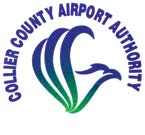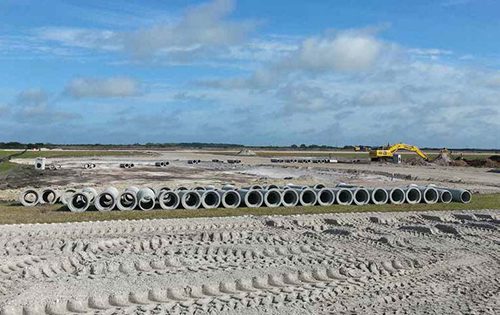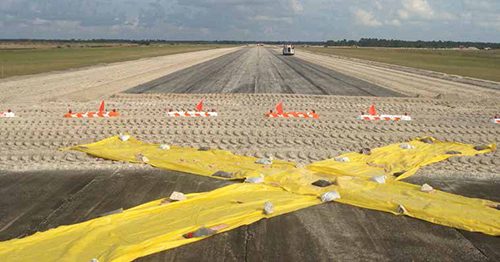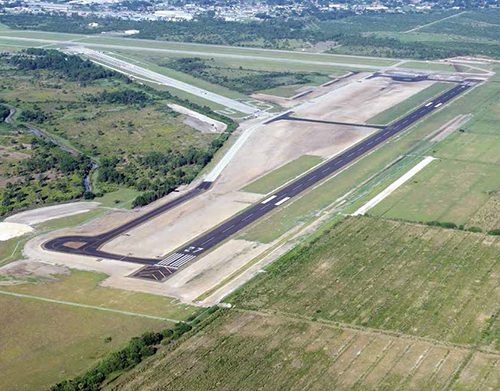Justin Lobb, manager at Immokalee Regional (IMM) in Florida, doesn’t mince words when he recalls how badly the airport’s north-south runway needed a major makeover: “The pavements showed signs of water intrusion and longitudinal cracking. The maze of drainage ditches between the runway and Taxiway B also presented maintenance challenges. Irregular grading had resulted in unsafe ponding and wildlife attraction conditions, and the area was accessible for maintenance only during the dry season.”
Originally constructed in 1942, Runway 9-27 had long served its useful life without any major improvements, explains Lobb. In 2006, the Florida Department of Transportation officially weighed in, declaring that IMM’s overall network of runways, taxiways and aprons was in poor condition. The airfield’s area-weighted average pavement condition index was 47, based on a 0 to 100 scale. By March 2011, IMM’s index had fallen to 36, earning it the dubious characterization of “very poor condition.”
Lighting deterioration was also an issue, given the runway’s stake-mounted incandescent medium-intensity system that dated back to 1966. “It needed to be upgraded to utilize an LED base-mounted runway light system with cable in conduit (vs. direct buried cable),” explains Lobb.
 factsfigures factsfiguresProject: Decoupling Runways; Reconstructing Runway & Taxiways Location: Immokalee (FL) Regional Airport Approx. Cost: $8 million ($46,800 under budget) Funding: FAA Airport Improvement Program; FL Dept. of Transportation; Collier County Construction Timeline: December 30, 2013 – November 19, 2014 Engineering, Design, Construction Management: Hole Montes Design & Construction Administration: URS Prime Contractor: Owens Ames Kimball Co. Paving: Community Asphalt Corp. Site Grading & Drainage: Caloosa Site Development Electrical: On-Power Services Quality Assurance Testing: Allied Engineering & Testing Environmental: Passarella & Assoc. Geotechnical Exploration & Plant Testing: Cal-Tech Ground Penetration Radar: Geoview Airport Geographic Information System: Woolpert Sinkhole Grouting: Hayward Baker Site Survey: Cooner & Assoc.; Hole Montes Lighting Fixtures: ADB Airport Solutions Markings: Roads & Runways Striping Services Key Elements: Decoupling runways & creating 450 ft. of separation between their thresholds; reconstructing runway, taxiways & connectors; improving airfield drainage; managing wildlife issues Of Note: Project was completed on schedule & under budget |
Beyond the specific shortcomings of Runway 9-27, IMM faced another more severe safety challenge: Its north-south runway (9-27) shared a common threshold with its east-west runway (18-36). To be eligible for state and federal funding, the thresholds would need to be decoupled and separated by at least 450 feet.
Fixing the airfield configuration problem and replacing aging pavement and lighting cost about $8 million.
At peak construction, prime contractor Owens Ames Kimball Co. had 50 to 60 people working at IMM. Matt Hoffman, the company’s executive supervisor, reflects back on the main elements of the nearly yearlong project: “We had to shut down the entire airport when we uncoupled the runways. We shifted 9-27 450 feet to the east, and the east end of the runway was extended 450 feet to maintain a 5,000-foot runway length. We completely rebuilt the runway.”
After crews removed old pavements, they cold milled the pulverized asphalt and base materials, which were later used to stabilize new safety areas and as sub-base material for a taxiway extension.
Ticking Clock
In August 2012, the Collier County Airport Authority received a nearly $800,000 FAA grant to fund 90% of the project’s initial costs – design, permitting and bidding. The Florida Department of Transportation (FDOT) and Collier County provided matching funds for the remaining 10%. FDOT and the county subsequently contributed another $45,000 each to pay for higher-than-anticipated county permitting costs and expenses associated with adding runway decoupling to the original design and bid specifications.
In May 2013, the condition of Runway 9-27 was downgraded to “serious” during another FDOT airfield pavement inspection. Because time was of the essence, airport officials divided the overall plan into a base project and three additional portions. This allowed them to solicit bids before funding was secured, because the airport could adjust the number of alternatives it executed based on the funding received. In the end, IMM received enough funding for all of its plans; but provisionally prioritizing key elements helped ease tensions during the wait.
The base project for improving Runway 9-27 included three major components: relocating the runway 450 feet to the east and reconstructing it; extending Taxiway B to the runway’s new east threshold; and constructing Taxiway B-1 to the threshold of the 9 end. The base project also added high-efficiency LED lighting for runway edge and threshold fixtures, plus new signage, home run cables and a regulator for the runway’s lighting circuit. Minor grading/drainage work and runway safety area improvements were included as well.
Alternative No.1 called for the relocation of Runway 18-36’s north threshold, construction of Taxiway A-2 connectors and removal of existing concrete pavement at the old intersection of the two runways and portions of taxiways A and B.
Alternative No. 2 covered the construction of Taxiway B-2, plus grading and drainage improvements. Other elements included runway end identifier lights and precision approach path indicator lights for both approaches to 9-27; edge lighting and signage for Taxiways A-2, B, B-1, B-2 and B-3; new segmented circle and wind cones; new home run cables in conduit; and a new electrical vault with backup generator.
Alternative No. 3 added blast pads at both ends of Runway 9-27 and hold pads on taxiways B-1 and B.
In September 2013, the FAA released about $6.75 million in Airport Improvement Program funds – enough to facilitate IMM’s base project and all three other plans. In addition, funds were provided to reconstruct Runway 9-27 at a width of 75 feet. FDOT subsequently committed $822,436 and Collier County chipped in another $487,040 to allow the airport to construct a 100-foot-wide runway. (The old runway was 150 feet wide to accommodate WWII aircraft, but IMM’s current aircraft mix requires less width.)
Environmental Issues
Before contractors could begin working, the Florida Fish and Wildlife Conservation Commission required the airport to survey the construction area for the habitats of two specific animals. The nests of burrowing owls were removed from July to February, when the protected birds weren’t using them. Gopher tortoises were relocated to a temporary holding pen built with 600 feet of wire-backed fencing.
Hole Montes, the lead design and engineering firm on the project, researched how IMM’s wildlife issues developed to devise a strategy for managing them. “When the airport was originally built, the military excavated drainage ditches in the area between the runway and taxiway,” says Luc Carriere, director of aviation engineering for Hole Montes. “Over time, the area became a wildlife attractant – great sites for burrowing animals. After removing the wildlife, we filled in the ditches and installed an underground drainage system that discharges into a canal and eventually the Gulf.”
The drainage improvements also significantly enhance water quality. Because runoff must now travel across grassy areas, contaminants are removed before the water is discharged into drainage pipes, Carriere explains.
Given the propensity for sinkholes throughout Southwest Florida, IMM’s airfield project raised some concerns about soil conditions. Intensive borings discovered some areas with voids or poorly consolidated soils 12 to 15 feet below the surface, reports Carriere. In areas where pavement required rehabilitation, crews used ground-penetrating radar to detect anomalies beneath the surface.
 “During World War II, if the military had an old jeep they wanted to get rid of, they might just bury it,” he notes. “Although we didn’t find any old jeeps, we did discover seven voids, which we filled with cementitious grout.”
“During World War II, if the military had an old jeep they wanted to get rid of, they might just bury it,” he notes. “Although we didn’t find any old jeeps, we did discover seven voids, which we filled with cementitious grout.”
Decoupling & Reconstruction
Construction began December 30, 2013, and followed a three-phase timeline that required alternating closures of runways 9-27 and 18-36. During phase one, 9-27 and Taxiway B were closed while crews reconstructed the runway, established a new threshold and built new taxiway extensions and connectors to meet the new threshold. Other elements of phase one included a run-up pad; new LED runway edge and threshold lights; new runway end identifier lights and precision approach path indicators on 9-27; and new LED edge lights and signage for Taxiway B and its new connectors.
Phase two began on May 20, 2014. The airport closed during nighttime hours so contractors could remove concrete pavement at the old junction of the two runways and a portion of Taxiway A connector north of the relocated Runway 18 threshold.
 On June 2, Runway 9-27 reopened and 18-36 closed. The Runway 18 threshold was moved 450 feet to the south, reducing 18-36’s total length to 4,550 feet. Crews also added a new Taxiway A-2 to the new threshold and installed a new electrical vault with a new backup generator.
On June 2, Runway 9-27 reopened and 18-36 closed. The Runway 18 threshold was moved 450 feet to the south, reducing 18-36’s total length to 4,550 feet. Crews also added a new Taxiway A-2 to the new threshold and installed a new electrical vault with a new backup generator.
During phase three, contractors removed the pavement connecting taxiways A and B and relocated runway end identifier lights and precision approach path indicators to the new threshold of Runway 18-36. The third and final phase was completed on August 26, 2014.
Because the quantity of bituminous surface course used was less than the amount listed in the bid, funds became available to rehabilitate an additional portion of Taxiway B not included in the original contract. Heavy equipment traffic during construction and two new pipe crossings had degraded the pavement. FDOT and FAA agreed that rehabilitation of Taxiway B was an eligible project expense and approved a change order to rehabilitate 1,500 feet of the taxiway.
 On Time, Under Budget
On Time, Under Budget
IMM’s airfield makeover wrapped up on November 19, 2014 – on time and nearly $47,000 under budget. Total cost was approximately $8 million.
Lobb describes the project as well managed and successfully executed, thanks to excellent collaboration among the various entities involved.
“We are still discovering the benefits of this project,” he reflects. “Our energy and airfield maintenance costs have decreased. Pilots appreciate the new runway and improved taxiway system. And we have received many compliments on our installation of PAPIs (precision approach path indicators), REILs (runway end identifier lights) and other guidance systems for approaching the airport. All in all, the improvements have made the airport more attractive to the flying public and resulted in increased use.”
According to Carriere, the airfield is now equipped for the next 20 years of development at IMM.





